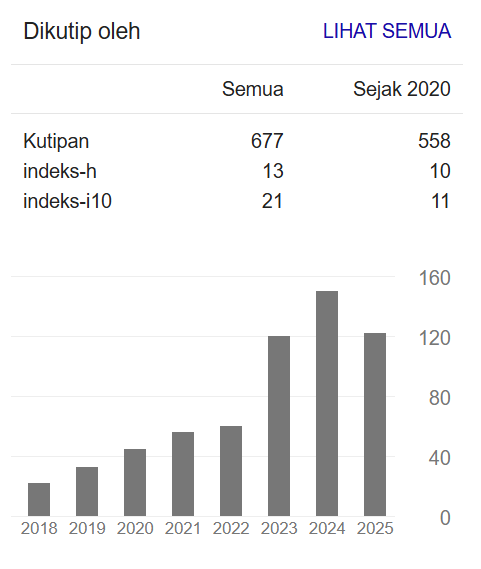STUDY COMPARISON ON KNOWLEDGE BY PRESENCE IN THE VIEWS OF IBN SĪNĀ, SUHRAWARDĪ, AND MULLĀ ṢADRĀ
DOI:
https://doi.org/10.20871/kpjipm.v9i2.291Keywords:
Knowledge by Acquaintance, Knowledge by Presence, Paradigm, Rational Demonstration, Self-KnowledgeAbstract
This article wants to describe the science of ḥuḍūrī according to three great philosophers from Ibn Sīnā, Suhrawardī, to Mullā Ṣadrā. Even though they both adopt ḥuḍūrī science, the three of them are different in terms of paradigm and also their implementation. This research uses general hermeneutic methods on the main books of Suhrawardī, Ibn Sīnā, and Mullā Ṣadrā as well as experts in the field. Ibn Sīnā accepted the science of ḥuḍūrī only as a science of the self because he adopted the plurality paradigm of wujūd. Suhrawardī and Mullā Ṣadrā focus more on ḥuḍūrī knowledge, not only self-knowledge but also developing other forms of wujūd. Even for Suhrawardī and Mullā Ṣadrā the only true knowledge is ḥuḍūrī knowledge. Mullā Ṣadrā with his ḥuḍūrī theory of science succeeded in building unity between epistemology and ontology because he defined science with the presence of non-material in non-material. The soul is a non-material entity still weak because it is tied to the body and must undergo substantial transformation with knowledge and charity. The source of knowledge is the non-material, active mind which bestows knowledge on the subject who has carried out catharsis and then there is unity between the two. External objects are not sources of knowledge, but stimulants. Science in general and the science of ḥuḍūrī, in particular, were also later developed further into the science of God.
Downloads
References
’Abdul-Haq, Muhammad. 1971. “Metaphysics of Mullā Ṣadrā: II.” Islamic Studies 10 (4): 291–317.
Abdullah, Abdullah. 2013. “Ilmu Huduri dan Kesadaran Kesatuan Mistikal (Tinjauan Kritis atas Pemikiran Mehdi Ha’iri Yazdi).” Sulesana: Jurnal Wawasan Keislaman 8 (1): 15–24. https://doi.org/10.24252/.v8i1.1272.
Afaki, Abdul Rahim. 2000. “The Notions of Māhiyyah and Eidos: A Comparison Between Sadrā’s Transcendent Philosophy and Husserl’s Phenomenology.” Transcendent Philosophy 2: 173–91.
Aftab, Macksood. 2006. “The Essential Ideas of Islamic Philosophy: A Brief Survey.” Journal of Islamic Philosophy 2 (1): 199–200. https://doi.org/10.5840/islamicphil20062110.
Aminrazavi, Mehdi. 2003. “How Ibn Sīnian Is Suhrawardī’s Theory of Knowledge?” Philosophy East and West 53 (2): 203–14. https://doi.org/10.1353/pew.2003.0010.
Behzad, Murtadai. 2013. “The Impact of Ibn Arabi’s Gnostic Unveilings Upon Mulla Sadra’s Philosophical Thoughts.” Khardname Sadra 67 (3): 129–64.
Burrell, David B. 2010. “Mullā Ṣadrā’s Ontology Revisited.” Journal of Islamic Philosophy 6 (July): 45–66. https://doi.org/10.5840/islamicphil201063.
Dakake, Maria Massi. 2004. “The Soul as Barzakh: Substantial Motion and Mullā Ṡadrā’s Theory of Human Becoming.” The Muslim World 94 (1): 107–30. https://doi.org/10.1111/j.1478-1913.2004.00043.x.
———. 2010. “Hierarchies of Knowing in Mullā Ṣadrā’s Commentary on the Uṣūl al-Kāfī.” Journal of Islamic Philosophy 6 (July): 5–44. https://doi.org/10.5840/islamicphil201062.
Eshaqnia, Sayyed Reza. 2020. “An Investigation of the Difference Among Mysticism, Philosophy, and Theology.” Journal of Naqd va Nazar (Philosophy and Theology) 25 (98): 138–63.
Fakhuri, Hanna al-, and Khalil al-Jurr. 2014. Riwayat Filsafat Arab. Translated by Irwan Kurniawan. Jakarta: Sadra Press.
Hood, Ralph. 2005. “Mystical, Spiritual, and Religious Experiences.” In Handbook of the Psychology of Religion and Spirituality, edited by Ray Paloutzian and Crystal Park, 348–64. New York: The Guilford Press.
Hosseini, Seyed Morteza, Jahangir Masoudi, and Meysam Azizian Mosleh. 2016. “Investigation of the Theory of Reference of Primitives to Present Knowledge (According to Ibn Sina and Misbah Yazdi).” Hekmat Sinavi 20 (55): 63–80.
James, William. 2004. Perjumpaan dengan Tuhan: Ragam Pengalaman Religius Manusia. Translated by Gunawan Admiranto. Bandung: Mizan.
Jurji, Edward J. 1940. “The Išrāqi Revival of Al-Suhrawardi.” Journal of the American Oriental Society 60 (1): 90–94. https://doi.org/10.2307/594566.
Kalin, Ibrahim. 2013. “From the Temporal Time to the Eternal Now: Ibn al-‘Arabi and Mulla Sadra on Time.” Journal of Religious Thought: A Quarterly Journal of Shiraz University 6 (19): 135–64. https://doi.org/10.22099/jrt.2013.1338.
Kamal, Muhammad. 2009. “Rethinking Being: From Suhravardi to Mulla Sadra.” Journal of Shi‘a Islamic Studies 2: 423–36.
———. 2016. Mulla Sadra’s Transcendent Philosophy. New York: Routledge.
Khatami, Mahmoud. 1996. “The Unitary Consciousness: Toward a Solution for the Ontological Crisis in Modern Theories of the Self.” Doctoral Thesis, Durham: Durham University.
Marcotte, Roxanne D. 2004. “Irjā‘ Ilā Nafsi-Ka Suhrawardī’s Apperception of the Self in Light of Avicenna.” Transcendent Philosophy 1: 1–22.
Medoff, Louis. 2011. “The Proof of the Veracious: An Exposition Based on ’Alamah Tabataba’i’s ‘Nihayat Al-Hikmah.’” Journal of Shi‘a Islamic Studies 4 (2): 183–97.
Muslih, Mohammad. 2009. “Kesadaran Intuitif Plus Cahaya Ilahiyah; Husserl di Muka Cermin Suhrawardi.” Tsaqafah 5 (1): 29–50. https://doi.org/10.21111/tsaqafah.v5i1.146.
Nasr, Seyyed Hossein. 1997. Three Muslim Sages Avicenna, Suhrawardi, Ibn Arabi. New York: Caravan Books.
Obaidullah, Muhammad. 2015. “Philosophical Sufism: An Analysis of Suhrawardi’s Contribution with Special Reference to His School of Illumination (Ishraqi).” Afkar: Jurnal Akidah & Pemikiran Islam 16 (1): 135–58. https://doi.org/10.22452/afkar.vol16no1.5.
Rizvi, Sajjad H. 1999. “An Islamic Subversion of the Existence‐Essence Distinction? Suhrawardi’s Visionary Hierarchy of Lights 1.” Asian Philosophy 9 (3): 219–27. https://doi.org/10.1080/09552369908575500.
———. 2009. Mulla Sadra and Metaphysics: Modulation of Being. London: Routledge. https://doi.org/10.4324/9780203879542.
Rustom, Mohammed. 2007. “Mullā Sadrā’s Prolegomenon to the Mafātīh al-Ghayb.” Journal of Qur’anic Studies 9 (1): 128–33. http://dx.doi.org/10.3366/jqs.2007.9.1.128.
Seitakhmetova, Natalie, Nurbol Kaldybekov, Madina Bektenova, Laura Toktarbekova, and Zhanara Turganbayeva. 2022. “The Role of Intellectual Islamic Heritage in the Discourse of Modern Islamic Philosophy.” Wisdom 24 (4): 172–83. https://doi.org/10.24234/wisdom.v24i4.803.
Shirazi, Mulla Sadra. 2004. On the Hermeneutics of the Light Verse of the Qur’an. Translated by Latimah-Parvin Peerwani. London: ICAS Press.
Suhrawardi, Yahya ibn Habash. 1998. Suhrawardi: The Shape of Light: Hayakal Al-Nur. Translated by Tosun Bayrak. Louisville, KY: Fons Vitae.
Walbridge, John Tuthill. 1996. “Suhrawardī, a Twelfth-Century Muslim Neo-Stoic?” Journal of the History of Philosophy 34 (4): 515–33.
Warno, Nano. 2021. “Metode Demonstrasi (Burhan) dalam Filsafat Islam.” Rausyan Fikr: Jurnal Ilmu Studi Ushuluddin dan Filsafat 17 (2): 297–330. https://doi.org/10.24239/rsy.v17i2.788.
Ziai, Hossein. 2001. “Shihāb Al-Dīn Suhrawardī: Founder of the Illuminationist School.” In History of Islamic Philosophy, edited by Oliver Leaman and Seyyed Hossein Nasr, 434–64. London: Routledge.
Downloads
Published
How to Cite
Issue
Section
License
Copyright (c) 2023 Nano Warno

This work is licensed under a Creative Commons Attribution 4.0 International License.





























